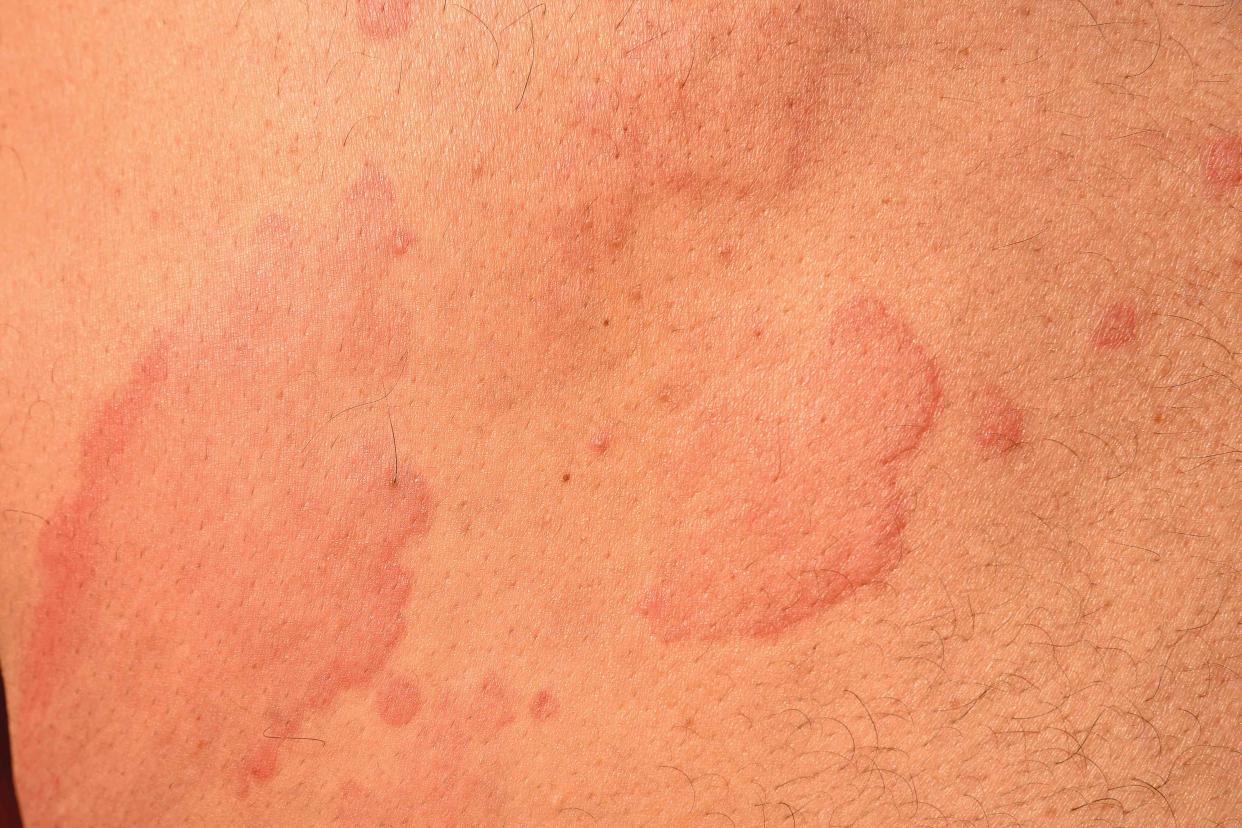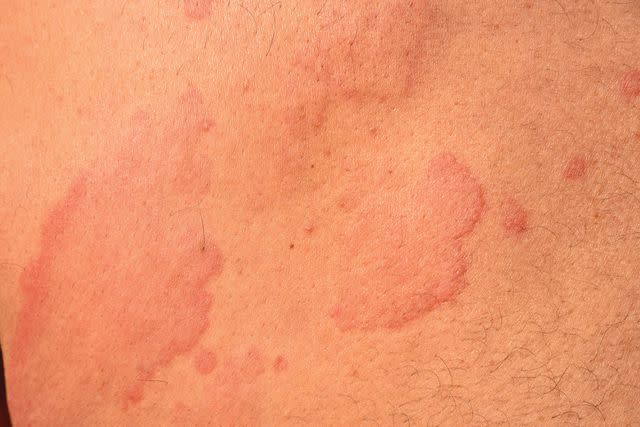Hives vs. Rash: What Are the Differences?

anand purohit / Getty Images
"Rash" is a general term used to describe a change in the regular appearance of your skin, whereas hives are a specific type of rash. Hives have a distinct appearance and typically occur in response to an allergen, although can appear without a specific cause. Getting hives accompanied by other symptoms like swelling or shortness of breath could indicate a severe allergic reaction.
This article will explore the symptoms, causes, and treatments to expect with hives that you might not see with other types of rashes.

anand purohit / Getty Images
Symptoms
Rashes and hives cause changes in the appearance of the skin and itching; however, there are some distinct differences.
Rash
Rashes can vary in appearance and cause a wide variety of symptoms, such as:
Itching
Redness
Dryness
Bumps
Peeling or cracking
Blistering
Warm or hot skin
Swelling
Hives
Hives are a specific form of rash with certain distinguishing features. They stand out from other types of rashes because sometimes, without treatment, they can appear and disappear quickly or migrate to another part of your body.
Hives usually appear as raised bumps that turn white (blanch) when you press them. They have a red or skin-colored base.
The appearance of hives remains the same regardless of the underlying cause. They will almost always appear red or the color of your skin and raised with a white blanchable center. Allergic hives often appear alongside other symptoms, which can indicate the need for immediate treatment. Signs of a severe allergic reaction (anaphylaxis) that can appear alongside hives include:
Swelling on the tongue, lips, or throat
Shortness of breath or wheezing
Light-headedness
Abdominal pain or cramping
Learn More:Pictures of Hives to Help Identify a Rash
Causes
Irritants and allergies are common triggers for rashes and hives. Rashes have a wide variety of triggers, and hives are a specific kind of rash. Hives can be acute (short-term) or chronic (long-term) and result from food, medication, insect stings, or an underlying illness or autoimmune condition.
Rash
Rashes can be caused by many things, from infections to simple irritations. The most common types of rashes are:
Eczema: Can be triggered by allergens or irritants; it is also a standalone diagnosis
Contact dermatitis: The result of any products such as fragrances or chemicals that cause irritation or inflammation to your skin
Hives: A type of rash usually caused by an allergy
Hives
Hives are a type of rash associated with allergic reactions. Causes of hives often include the following:
Insect stings or bites
Certain foods
Pet dander
Sunlight
Vibrations (vibratory angioedema, when the skin is in contact with a vibrating object)
Extreme cold or heat
Certain medications
Viral infections
Bacterial infections
Blood transfusions
Diagnosis
Healthcare providers usually diagnose hives by doing a physical examination. They will likely ask about your history of allergies and previous rashes. If your hives are caused by an allergic reaction, a healthcare provider will direct you to take steps to prevent and treat future allergic reactions. You might even be referred to an allergy specialist (allergist).
If your hives last longer than a few weeks, you may need additional allergy skin testing or tests using your blood or urine to identify triggers.
If your healthcare provider suspects another kind of rash other than hives, they may want to scrape away some skin cells for examination under a microscope. This process helps the provider identify a more precise cause of your skin rash or irritation. You may also undergo tests like a patch test or biopsy (removing a sample of skin for analysis in a lab) to uncover the cause of your rash or hives, depending on any other symptoms you're experiencing.
Read Next:Skin Rashes Types and Causes in Children
Treatment
The treatment of rashes vs. hives depends on the underlying cause.
Hives
Hives usually go away on their own within a day or so. Providers often take a three-pronged approach when treating hives, which includes:
Controlling the itching
Preventing new hives
Avoiding the underlying cause
Severe and persistent cases of hives might require medications, including:
Anti-itch creams or lotions
Antihistamines, such as Zyrtec (cetirizine) or Benadryl (diphenhydramine)
Corticosteroids, such as Rayos (prednisone)
Xolair (omalizumab)
Hives associated with severe allergic reactions could require emergency care.
Rashes
Since there are various causes for rashes, the treatment also varies. Most rashes can be treated at home with over-the-counter antihistamines or topical creams. However, there are cases of rashes that can indicate something more serious. Characteristics of rashes that should prompt medical attention include:
A full-body rash
A rash with a fever
A rash that comes on quickly and spreads
A painful or blistering rash
An infected rash
Learn More:12 Effective Ways to Treat Hives
Prevention
Identifying allergies or sensitivities that trigger rashes or hives is the best prevention strategy. This can mean avoiding certain fabrics or changing your laundry detergent.
Your healthcare provider can perform testing to help you identify specific allergies. Allergic reactions are unpredictable. For food and medication allergies, the best way to prevent a reaction is to avoid the trigger.
If allergies don't cause your hives or rashes, good skin care practices like minimizing sun exposure can help, as well as relaxation therapies for hives triggered by stress.
Related:A Guide to Which Rashes You Should Worry About
Summary
"Hives" and "rashes" are often used interchangeably to describe a change in the typical appearance of your skin. However, it is important to distinguish the differences between the two terms.
Rashes can take many forms and appear for various reasons, whereas hives are a type of rash that is red or the color of your skin and blanch when touched. An allergy usually causes hives. If you experience other symptoms with hives, like shortness of breath or swelling, seek immediate medical attention.

